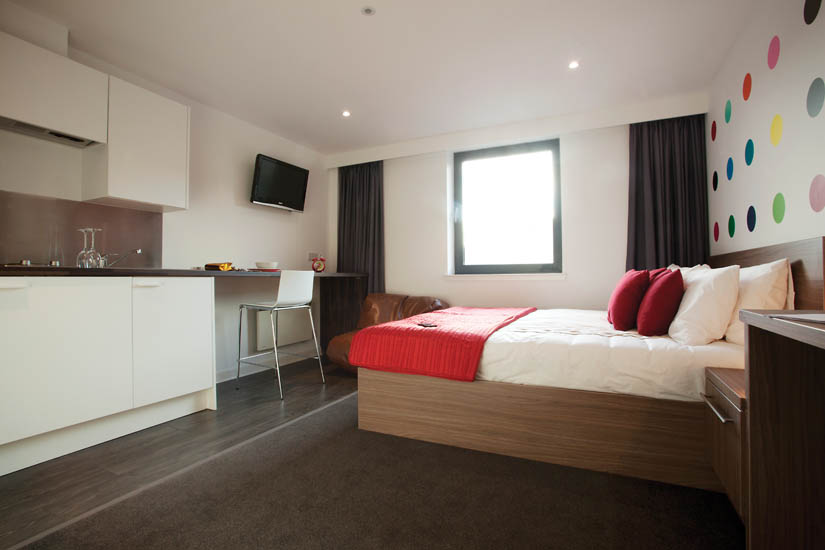Student accommodation
Contents |
[edit] Introduction
The market for student accommodation in the UK is increasingly buoyant, with universities now competing openly for students and funds. In 2017, £5.3bn was expected to be invested in purpose-built student accommodation, compared to £4.5bn in 2016, and a record £6bn in 2015.
Traditionally, students mostly relied on the private sector for accommodation. However, the supply from small-scale private landlords has been proportionally lower over the last decade-or-so due to greater the greater number of university places, increased regulation, rising house prices, and so on.
Specialist developer-operators have emerged to provide large-scale developments, either marketed to students directly or on behalf of universities. This has led to a steady increase in expected standards, with universities that lack quality accommodation risking deterring potential students from applying to study there.
High-quality, cost-effective student accommodation has become an integral part of higher education provision, as well as a relatively safe and high-performing investment.
[edit] Considerations
Some of the stakeholder considerations for student accommodation include:
- Universities require good-quality, well-located residences that will attract potential students, and be cost-effective to operate and maintain.
- Students require accommodation that will facilitate their transition to independent living and provide opportunities to socialise and study successfully.
- Parents require assurances that accommodation is safe, well-catered, and good value for money.
- Investors require accommodation that provides a reliable, long-term income stream, with short lettings that can easily be adjusted.
- Local communities require student accommodation that is well-managed and carefully located, as the typically transient, and sometimes disruptive, occupants can have a negative impact on existing communities.
In terms of design, student accommodation tends to be provided in a quite simple building type, with few complex building services and little provision for long-term flexibility. While an abundance of highly-functional but dull and repetitive accommodation blocks have been built in recent years, some projects have proved that quality is possible, even within tight budgets and deadlines.
[edit] Design
Economies of scale can be achieved in larger developments through the use of repetitive room types. Modern methods of construction, such as modular construction and prefabrication can be used to deliver good quality at high volumes. A typical en-suite student bedroom is around 12-13 sq. m.
As there will is less opportunity to reduce costs on bedroom space allowances, other areas that can be considered for efficiencies include:
- Extent of circulation space: Although less social space may prove less attractive to students.
- Arrangement of circulation space: Selection of an access and circulation strategy based on multiple cores, cores and corridors, and so on.
- Communal facilities: Such as the number of bedrooms per kitchen, common rooms, bars, laundries, gyms, and so on.
- Substructure and roofing: Can have a disproportionate impact on costs if non-standard solutions are specified.
Other design considerations include:
- Ability to personalise space.
- Adequate storage facilities.
- Durability, particularly of finishes, fixtures, and furniture.
- Provision of services during periods of demand, such as hot water during mornings, internet connection during evenings.
- Options for individual control of room temperature.
- Ease of maintenance while achieving minimal disruption to students.
- Appropriate security measures.
- Reducing carbon emissions, managing water and specifying materials with a low environmental impact.
[edit] Procurement
Some university clients commission one-off schemes following traditional sequential procurement routes. The majority, however, tend to adopt a form of partnership approach to their accommodation delivery, through a lease agreement with a developer, or through nomination or reservation agreements with an independent service provider.
Most clients will use a form of Design and Build, with some initial, directly-appointed consultant design input.
Since schemes often need to be completed before the academic year begins, developers can be dependent on careful supply chain management, such as year-round production of prefabricated bedroom modules to be able to supply sufficient units in advance of the critical on-site phase.
[edit] Find out more
[edit] Related articles on Designing Buildings Wiki
Featured articles and news
Latest Build UK Building Safety Regime explainer published
Key elements in one short, now updated document.
UKGBC launch the UK Climate Resilience Roadmap
First guidance of its kind on direct climate impacts for the built environment and how it can adapt.
CLC Health, Safety and Wellbeing Strategy 2025
Launched by the Minister for Industry to look at fatalities on site, improving mental health and other issues.
One of the most impressive Victorian architects. Book review.
Common Assessment Standard now with building safety
New CAS update now includes mandatory building safety questions.
RTPI leader to become new CIOB Chief Executive Officer
Dr Victoria Hills MRTPI, FICE to take over after Caroline Gumble’s departure.
Social and affordable housing, a long term plan for delivery
The “Delivering a Decade of Renewal for Social and Affordable Housing” strategy sets out future path.
A change to adoptive architecture
Effects of global weather warming on architectural detailing, material choice and human interaction.
The proposed publicly owned and backed subsidiary of Homes England, to facilitate new homes.
How big is the problem and what can we do to mitigate the effects?
Overheating guidance and tools for building designers
A number of cool guides to help with the heat.
The UK's Modern Industrial Strategy: A 10 year plan
Previous consultation criticism, current key elements and general support with some persisting reservations.
Building Safety Regulator reforms
New roles, new staff and a new fast track service pave the way for a single construction regulator.
Architectural Technologist CPDs and Communications
CIAT CPD… and how you can do it!
Cooling centres and cool spaces
Managing extreme heat in cities by directing the public to places for heat stress relief and water sources.
Winter gardens: A brief history and warm variations
Extending the season with glass in different forms and terms.
Restoring Great Yarmouth's Winter Gardens
Transforming one of the least sustainable constructions imaginable.























